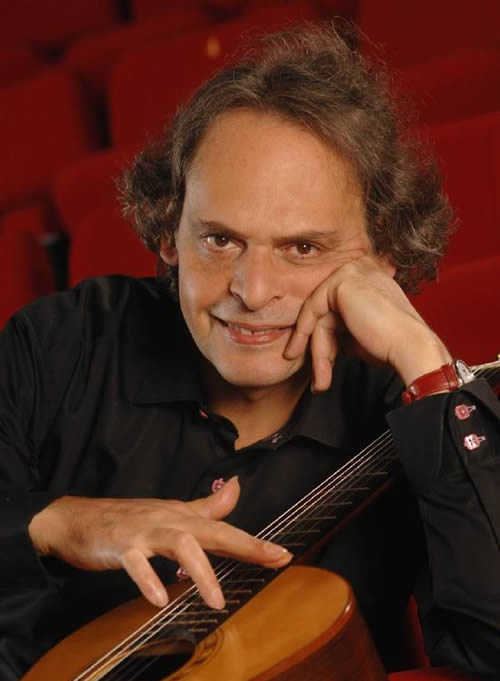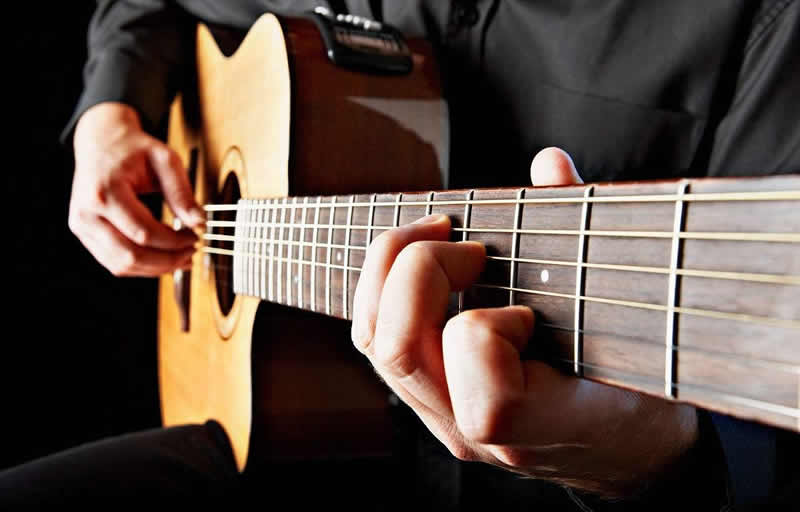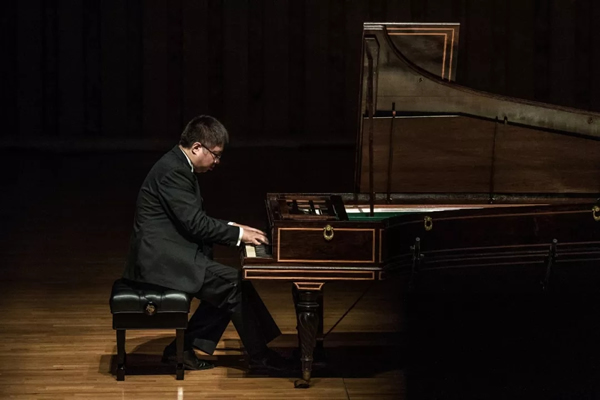古典吉他家们是如何背谱的?(编译连载全文)
第一章:引言
第二章:文献综述
第三章:研究方法
精英吉他家访谈录(1)丹尼斯、库里科娃
精英吉他家访谈录(2)卢卡斯
精英吉他家访谈录(3)维莱加斯
精英吉他家访谈录(4)苏萌、瓦丹燕、杰森
第四章:研究结果
第五章 总结与结论
总结
本文开头一章指出,记忆音乐没有通用的方法。存在几种技巧,学生必须通过反复试验找到哪种技巧适合他们。学生们有时会接受这样的想法,即有些人比其他人更好地记住音乐,虽然这可能是真的,但每个人都可以努力学习和记忆技巧,并取得成功。关于这个问题,曼努埃尔·巴鲁埃科说,“如果你是那种在表演中会怀疑自己记忆力的演奏者,那么你可以通过确保事情非常清楚、更好地做好准备,这样当怀疑来临时,你就有了答案。”
这项研究的结果与所综述的大多数文献一致。显然,每个接受采访的人都为自己的信念和方法提出了有效的论据。我相信,虽然一些受访者用不同的词来描述他们的记忆过程,但大多数记忆技巧是相似或重叠的。
所有音乐家的工作方式都不同,他们可能采用的记忆技巧也是如此。当被问及他们使用了什么记忆技巧时,所有参与者都认为肌肉记忆是最重要的。然而,他们明确表示,这并不意味着无意识的重复。相反,肌肉记忆的成功与否取决于他们在练习过程中的注意力水平。所有与会者都提到需要慢慢练习。了解我们在演奏音乐时的所有动作是极其重要的。我们如何练习将决定将如何表现。通过有意识地监控练习方式,可以避免紧张、焦虑和错误。卢卡斯认为,如果你演奏了足够多的时间而没有犯错误,这就是大脑在演奏会期间所能记住的一切,演奏得非常干净。理查德·普洛斯特同意这种观点,并解释了相反做法的后果,“如果十次中有九次弹得不好,成为常态,那么你现在已经成功地练失败了。”
几位参与者谈到,吉他手研究乐谱,并选择在表演中使用的指法是多么的重要。伊琳娜·库里科娃甚至提到了她过去作为裁判的经历,当时非常著名的吉他手在比赛中犯了错误或记忆力衰退,因为他们在演出前一晚换了指法。一名参与者还讨论了练习孤立右手动作的益处。为了做到这一点,吉他手必须知道左手弹奏的所有音符,何时弹拨,何时等待左手发出的声音。这会加强对乐器的了解,并转化为更安全的表演。
此外,所有参与者都认为音乐家必须理解所研究作品的组成和和声结构。通过理智地分析乐曲并仔细研究手指如何操作,吉他手正在创建一个关联网络,以提高音乐记忆保留的容量和速度。
除库卢卡斯外,所有接受采访的吉他手都进行了可视化练习,以增强记忆。运动想象似乎是对抗记忆减退的终极测试,其结果可能具有心理学意义,因为吉他手在演奏时会减少焦虑。
结论
基于本研究的发现和第二章中提到的早期出版物,我坚信有可能为古典吉他创造一种成功的记忆方法。音乐记忆不仅需要有吸收和保留信息的能力,还需要在表演过程中检索信息的能力。因此,一个成功的方法应该包括有效的学习技巧和措施,以应对或避免表演时的分心。
这是一种基于研究的方法,分五个阶段练习和记忆音乐:乐谱分析、运动分析、肌肉重复、可视化和环境变化。第一阶段包括在练习课之前分析正在学习的作品的乐谱。有几种方法可以研究乐谱,虽然传统的和声或乐理分析在理解乐曲的性质方面很有用,但这一阶段专门处理结构和乐句分析。这一步的目的不是让吉他手在演奏过程中积极思考乐曲的结构,而是创建更快学习和更深入理解乐曲所需的联想和思维导图。鲁宾·拉布森(Rubin Rabson)在1937年至1940年间的早期研究支持了该方法分析部分的有效性。
该方法的第二阶段仅适用于学生学习新作品的情况。这一步包括分析音乐并决定哪种指法最适合每个部分。找到每次指法的逻辑原因,将进一步加强前一步中创建的关联。学生还应在关键部分做好标注,例如,准确地知道哪些左手和右手手指弹奏具有挑战性的音阶或乐段的开头。在进行肌肉重复之前,应分析所有的指法,而不是在由于一节中指法笨拙而重复出错之后。
必须理解,肌肉重复阶段指的是一个非常集中的练习环节,双手完全被分析和控制,没有任何动作是偶然或直觉造成的。这部分方法的目标不仅是多次演奏音乐片段,而且还要多次完美地演奏音乐片段。虽然有意识的注意力一次只能集中在一件事上,但潜意识能够同时指导多项任务。因此,当一个学生在重复一段音乐时,潜意识不会失去任何印象,所有的东西都会记录下来,甚至是错误。这就是为什么所有接受本研究采访的吉他手都提到慢练的原因,也是卢卡斯这样练琴的原因。
在第三阶段,学生将发现双手分开练习非常有益。1939年,鲁宾·拉布森得出结论,在练习键盘时双手分开会带来更好的稳定性和清晰度。古典吉他也是如此。练习左手时,学生应专注于小而有效的动作,以及手和手指从一个位置跳到另一个位置时的样子。右手隔离可以加强古典吉他手的记忆;为了知道要拨动哪根弦,吉他手必须清楚地知道每根弦上演奏了多少个音符,包括任何会导致左手移动而右手等待下一个音符的音。
该方法的第四阶段涉及运动可视化,即离开吉他时双手运动的心理可视化。这一阶段应该在睡觉前练习,同时大脑更有效地吸收信息。科学表明,参与运动想象有助于运动规划,增加对音乐元素(如时间和音色)的控制,并增强记忆力。库里科娃发现,通过视觉化音乐,她能够在更短的时间内学习更多的音乐,这一点得到了研究结论的支持,即心理练习和身体练习的结合,可以与单独的身体一样有效或更有效,在记忆的过度学习阶段,综合练习优于身体练习。该方法的可视化阶段对于在演出期间有效检索信息至关重要。通过能够在脑海中创建所有手部动作的图像,表演者的大脑将始终领先一步,向手指发送命令,而不是试图找出下一步的动作。
最后,库里科娃和卢卡斯都提到了环境可能会影响表演效果,这与第二章中提到的巴克林和米什拉的发现一致。对于该方法的最后一个阶段,建议学生在不同的环境中练习,以减少或消除表演时环境变化造成的任何干扰。
我相信这种方法对大多数学生和专业古典吉他手来说都是成功的。由此产生的挑战是,无法监控学生在练习期间的注意力集中程度。所有参与者都提到专注是他们学习方法的一个重要方面。如果学生在练习过程中全神贯注,则进入该过程的所有音乐分析、所有指法选择和动作重复都将转化为记忆保留。出现的另一个挑战是初学者无法正确遵循这种方法;一些阶段,如第一和第二阶段,可以由老师适当监督,然而,可视化阶段对于初学者来说将很难,并且没有经验丰富的演奏家那么有效。
在第二章中提到的研究中,没有一项能够找到一天中有效练习的具体时间,概述一次练习应该多长时间,或者应该包括多少休息时间。然而,我相信,遵循这五部分方法的学生将能够成功地记住音乐,并在表演中找回音乐。
(全文完)
参考文献:
Arbib, Michael A. Language, Music, and the Brain: A Mysterious Relationship. 2013.
Azabagic, Denis. On Competitions: Dealing with Performance Stress. Pacific, MO: Mel Bay Publications, 2003.
Bangert, Marc, Thomas Peschel, Gottfired Schlaug, Michael Rotte, Dieter Drescherm Hermann Hinrichs, Hans-Jochen Heinze, Eckart Alten Altenmüller. “Shared Networks for Auditory and Motor Processing in Professional Pianists: Evidence from fMRI Conjunction.” NeuroImage. Vol. 30, No. 3 (2006): 917-926. Accessed November 2, 2016. http://www.sciencedirect.com.access.library.miami.edu/science/article/pii/S10538 11905024158
Barrueco, Manuel. “On Turning Fifty: A Conversation.” Soundboard, Vol XXIX, No. 4 (2003): 76-86.
Baumann, Simon, Susan Koeneke, Conny Schmidtm Martin Meyer, Kai Lutzm Lutz Jancke. “A Network for Audio-Motor Coordination in Skilled Pianists and Non- Musicians.” Brain Research. Vol. 1161 (2007): 65-78. Accessed November 1, 2016. http://dx.doi.org.access.library.miami.edu/10.1016/j.brainres.2007.05.045
Beisteiner, R, P. Höllinger, G. Lindinger, W. Lang, A. Berthoz. “Mental Representations of Movements. Brain Potentials Associated with Imgination of Hand Movements.” Electroencephalography and Clinical Neurophysiology, 96 (1995): 183-193.
Bernardi, Nicolò, Alexander Schories, Hans-Christian Jabusch, Barbara Colombo, Eckhart Altenmüller. “Mental Practice in Music Memorization: an Ecological- Empirical Study.” Music Perception: An Interdisciplinary Journal. Vol. 30, No. 3 (2013): 275-290. Accessed October 29, 2016. Doi: 10.1525/mp.2012.30.3.275.
Bernstein, Seymour. With Your Own Two Hands. New York: Schirmer, 1985.
Bonell, Carlos. “Memory’s Mysterious Moods 2: Three Steps to Memorizing Music.”
Classical Guitar Magazine Vol 31, No. 4 (December 2012): 30.
Brown, Roberta. "A Comparative Study of the 'Whole,' 'Part,' and 'Combination' Methods of Learning Piano Music." Journal of Experimental Psychology 11, No. 3 (June 1928): 235-247. PsycARTICLES, EBSCOhost (accessed February 21, 2017).
Bruser, Madeline. The Art of Practicing: A Guide to Making Music from the Heart. New York: Bell Tower, 1999.
Caponigro, Andrew. “Let Not Thy Left Hand Know What Thy Right Hand Doeth.” Guitar Review, 34 (Winter 1971): 28-29.
Cervino, Alessandro. The Practice of Practising. Leuven: Leuven University Press, 2011.Chissell, Joan. Clara Schumann: A Dedicated Spirit. NY: Taplinger Publishing, 1983.
Chaffin, Roger, Gabriela Imreh, and Mary Crawford. Practicing Perfection: Memory and Piano Performance. Mahwah, N.J.: Lawrence Erlbaum, 2002.
Clark, Frances. Questions and Answers: Practical Advice for Piano Teachers. Illinois: The Instrumentalist Company, 1992.
Coffman, Don. “Effects of Mental Practice, Physical Practice, and Knowledge of Results on Piano Performance.” Journal of Research in Music Education. Vol. 38, No. 3 (Autumn, 1990): 187-196. Accessed November 1, 2016. http://www.jstor.org.access.library.miami.edu/stable/3345182.
Dakan, Jacob and Abbey Dvorak. “Teacher Perceptions of Memorization in String Instructional Settings: An Exploratory.” Bulletin of the Council for Research in Music Education No. 202 (Fall 2014): 29-49.
Dehn, Milton. Helping Students Remember: Exercises and Strategies to Strengthen Memory. Hoboken, NJ: John Wiley & Sons Inc., 2011.
Dickinson, Stefanie. “A Multi-level Approach to More Secure Memorization.” College
Music Symposium 49/50 (2009): 271-283. Accessed February 20, 2016,
Ross, Edgar. "Improving Facility in Music Memorization." Journal of Research in Music Education 12, No. 4 (1964): 269-278.
Engel, Annerose, Marc Bangert, David Horbank, Brenda Hijmans, Katharina Wilkens, Peter Keller, Christian Keysers. “Learning Piano Melodies in Visuo-Motor or Audio-Motor Training Conditions and the Neural Correlates of Their Cross- Modal Transfer.” NeuroImage. Vol. 63, No. 2 (2012): 966-978. Accessed November 2, 2016. http://dx.doi.org.access.library.miami.edu/10.1016/j.neuroimage.2012.03.038
Feltz, Deborah, Daniel Landers. “The Effects of Mental Practice on Motor Skill Learning and Performance: A Meta-analysis.” Journal of Sport Psychology. Vol. 5, No. 1 (1983): 25-57. Accessed November 1, 2016. SPORTDiscus with Full Text, EBSCOhost.
Gordon, Stewart. Mastering the Art of Performance: A Primer for Musicians. New York: Oxford University Press, 2006.
Green, Barry, and W. Timothy Gallwey. The Inner Game of Music. Garden City, NY: Anchor Press/Doubleday, 1986.
Green, Elizabeth A. H. Practicing Successfully: A Masterclass in the Musical Art. Chicago: GIA Publications, 2006.
Greer, Amy. " Rattling the Cage." American Music Teacher 53, no. 5 (2004): 32-35.
Hall, Craig, Wendy Rodgers, Kathryn Barr. “The Use of Imagery by Athletes in Selected Sports.” The Sport Psychologist. Vol 4, No. 1 (1990): 1-10. Accessed November 2, 2016. SPORTDiscus with Full Text, EBSCOhost.
Hiller, Ferdinand. “Conducting from Memory.” Dwight’s Journal of Music, 32 (1872): 1- 45.
Hodges, Donald A. “Implications of Music and Brain Research.” Music Educators Journal 87, No. 2 (2000): 17-22.
Isbin, Sharon. Classical Guitar Answer Book. California: String Letter Publishing, INC., 1999.
Johnson, Randolph. “Musical Tempo Stability in Mental Practice: A Comparison of Motor and Non-Motor Imagery Techniques.” Research Studies in Music Education. Vol. 33, No. 1 (2011): 3-30. Accessed November 3, 2016. http://rsm.sagepub.com.access.library.miami.edu/content/33/1/3
Johnston, Philip. Practiceopedia. Pearce, Australia: PracticeSpot Press, 2006. Kenny, Dianna. “Music Performance Anxiety: Is it the Music, the Performance or the Anxiety?” Music Forum, 10 (2004): 38-62.
_________. Negative Emotions in Music Making: Performance Anxiety, Handbook of Music and Emotion: Theory, Research, Applications. Oxford, UK: Oxford University Press, 2009.
Klickstein, Gerald. The Musician's Way: A Guide to Practice, Performance, and Wellness. Oxford: Oxford University Press, 2009.
Kopfstein-Penk, Alicia. “The Art of Memorization.” Guitar Review No. 91 (Fall 1992):27-33.
Lang, Peter. Art in Motion: Musical and Athletic Motor Learning & Performance. Frakfurt: Frankfurt am Main, 2009.
Lorimer, Michael. “Spotlight on Michael Lorimer.” Guitar Review No. 53 (Spring 1983): 10-15.
Lotze, M., G. Scheler, H.-R.M. Tan, C. Braun, N. Birbaumer. “The Musician’s Brain: Functional Imaging of Amateurs and Professionals During Performance and Imagery.”NeuroImage. Vol. 20, No. 3 (2003): 1817-1829. Accessed November 1, 2016. http://dx.doi.org.access.library.miami.edu/10.1016/j.neuroimage.2003.07.018
Mackinnon, Lilias. Music by Heart. London: Oxford University Press, 1938.
Meister, I.G., T. Krings, H. Foltys, B. Boroojerdi, M. Müller, R. Töpper, A. Thron. “Playing Piano in the Mind – An fMRI Study on Music Imagery and Performance in Pianists.”Cognitive Brain Research. Vol. 19, No. 3 (2004): 219-228. Accessed November 1, 2016. http://dx.doi.org.access.library.miami.edu/10.1016/j.cogbrainres.2003.12.005
Mishra, Jennifer. “A Century of Memorization Pedagody.” Journal of Historical Research in Music Education, 32.1 (Oct. 2010): 3-18. Accessed February 20, 2016 http://access.library.miami.edu/login?url=http://go.galegroup.com/ps/i.do?id=GA LE%7CA288538149&sid=summon&v=2.1&u=miami_richter&it=r&p=EAIM&s w=w&asid=af47a88e36cd6918e155d7c7dbced491
_________. “A Qualitative Analysis of Strategies Employed in Efficient and Inefficient Memorization.” Bulletin of the Council for Research in Music Education, No. 152 (Spring 2002): 74-86.
Mishra, Jennifer and William Backlin. "The Effects of Altering Environmental and Instrumental Context on the Performance of Memorized Music." Psychology of Music 35, No. 3 (2007): 453-472.
Maisel, Eric. Performance Anxiety: A Workbook for Actors, Singers, Dancers, and Anyone Who Performs in Public. New York, NY: Back Stage Books, 2005.
Oshima-Ryan, Yumiko. “Not Always by Memory.” Clavier, 45 (2006): 21-32. Ostwald, Peter. “Historical Perspectives on the Treatment of Performing and Creative
Artists.” Medical Problems of Performing Artists, 9(4) (1994): 113–18.
Parks, Richard D. How to ... Overcome Stage Fright. Fremont, CA: F-P Press, 1979.
Perry, Francis. “A Recipe for Learning a New Piece of Music” Soundboard Vol XXXV, No. 2 (2009): 38-39, 87.
Provost, Richard. “Performance Anxiety: A Different Approach to Performance for Classical Guitarists.” Soundboard, Vol XVII, No. 4 (Winter 1991): 23-25.
_________.The Art & Technique of Practice. California: Guitar Solo Publications, 1992. _________. “The Art and Technique of Practice, Part 4.” Soundboard Vol XVI, No. 4(Winter 1989-90): 49-51.
Reubart, Dale. Anxiety and Musical Performance. New York, NY: Da Capo, 1985.
Rubin-Rabson, Grace. "Studies in the Psychology of Memorizing Piano Music: III. A Comparison of the Whole and the Part Approach." Journal of Educational Psychology 31, No. 6 (1940): 460-476.
_________. "Studies in the Psychology of Memorizing Piano Music. I. A Comparison of the Unilateral and Coordinated Approaches." Journal of Educational
Psychology 30, No. 5 (1939): 321-345.
_________."Studies in the Psychology of Memorizing Piano Music: II. A Comparison of Massed and Distributed Practice." Journal of Educational Psychology 31, No. 4 (1940): 270-284.
_________. "Studies in the Psychology of Memorizing Piano Music. IV. The Effect of Incentive." Journal of Educational Psychology 32, No. 1 (1941): 45-54.
Shockley, Rebecca. Mapping Music: For Faster Learning and Secure Memory. Wisconsin: A-R Editions, 2001.
Solovitch, Sara. Playing Scared: A History and Memoir of Stage Fright. 2015.
Soria-Urios, Gema, Pablo Duque, and José M. García-Moreno. 2011. “Music and brain (II): Evidence of musical training in the brain.” Revista De Neurologia 53 (12): 739-46.
Thaut, Michael. Rhythm, Music, and the Brain: Scientific Foundations and Clinical Applications. New York: Routledge, 2005.
Zdzisław Jachimecki. Chopin, Fryderyk Franciszek: Polski słownik biograficzny.
Kraków, Polska Akademia Umieje ̨ tnos ́ci, (Vol. III), 1937.




